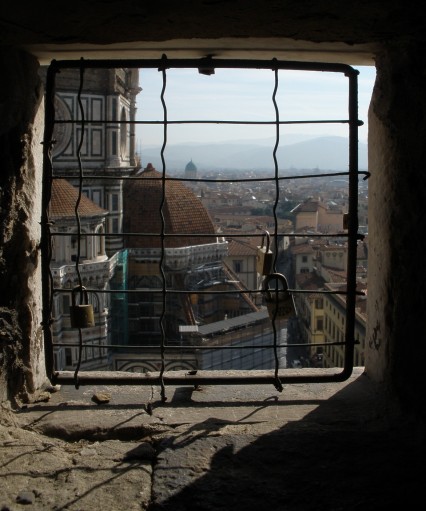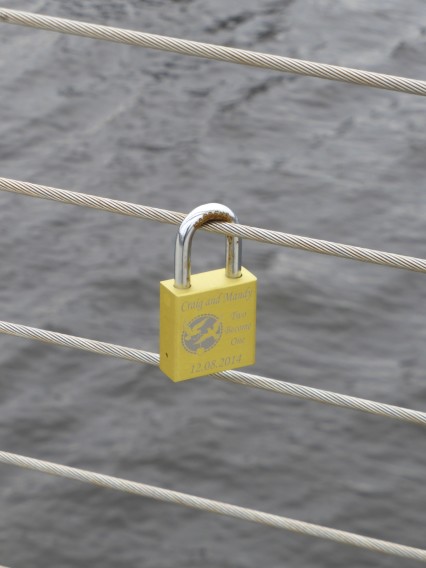“Harmless intervention or a blight?” Richard Porch explores the love lock, a recent spontaneous artwork spreading its way across Europe.

They can be seen in cities with as little in common as Florence and Swansea. They have come to adorn (if that’s the right word) bridges or windows that have any form of wire fencing fixed to them. For obvious reasons – i.e. their sheer footfall – public buildings or spaces where tourists congregate tend to accumulate lots of them. I’m talking about ‘Love Locks’, the small padlocks that can be bought at any hardware or DIY superstore for a few pounds. They are then inscribed with the names of the two lovers involved and then attached to wire grating or railing and then the key is thrown away. Into the immediately adjacent river if the lock is attached to a bridge or presumably out of the window if the grating covers an opening. Having seen them attached to a window grating in the Giotto Tower (immediately adjacent to the Duomo) in Florence I can’t imagine this is always the case, though. The result is a more or less permanent reminder of the love two people have for one another inserted into the public realm as some sort of signifier. The fact that only the two lovers involved can know who the lock is dedicated to, despite the public nature of the declaration is, apparently neither here nor there. That declaration and its very feral existence, unasked for and unavoidable, poses some interesting issues though.
I was inspired to write about them as I discovered a few attached limpet-like to the ‘Sail Bridge’ that spans the Tawe in Swansea and links the Marina with the SA1 docklands development. These symbols of undying love are now ubiquitous in most parts of Europe and their very existence seems symptomatic of an ongoing colonisation of the public realm by the ordinary citizen. What began with graffiti and continued with the roadside floral tribute has continued with the festooning of bridges and public buildings with cheap padlocks. I suppose the underlying question is; are they a harmless intervention or a blight?

It is difficult to write meaningfully about them without sounding like some miserable old git. It doesn’t help that I see them as an offshoot of the me-generation and the need to ‘share’ (code for ‘impose’) my tastes upon all and sundry. This is an outgrowth of the social media revolution whose technology has given everyone a soapbox from which to tell the world what they are doing in real-time uninhibited by any editorial or critical dimension. The result is that everyone thinks their opinion or values now matter or are worth something – when in fact most aren’t worth the energy tied up in typing that last sentence. There, I told you this subject would make me seem like an old git.
Back to Love Locks. These are intrusion into the built environment or – as I suppose we must call it now – the public realm. Like the floral tributes tied to roadside railings laid whenever someone is run over, they are ‘feral’ in that they were not ‘commissioned’ but added later and on the initiative of relatives or close friends. The Love Lock is supposed to represent undying love as symbolised by the padlock. In previous decades such declarations of love would have been made via the printed ephemera of letters and then postcards. Then would come the telephone, the email and ultimately the text message. The trend has been towards greater immediacy of contact and response, however concomitant with this is a lack of tactility. Characters on a Smartphone or in the ‘blogosphere’ have no physical dimension. This is where the padlock comes in. The problem is that this symbol of undying love – deployed in any great number – soon becomes a very definite intrusion into public space. In France some bridges are encrusted with these locks forming an unsightly carapace which the civic authorities periodically have to cut back. Officials come armed with bolt cutters to prune them away and reveal the bridge beneath only for devoted couples to re-apply them a matter of hours later. One alternative has been to create a wire fence to mask the bridges structure and allow the lovesick to apply their locks to that, rather than ornament the bridge proper. Either way the advent of the love lock is, by virtue of its crowd-sourcing nature, affecting the built environment in an unforeseeable way that is both divisive and (arguably) decorative. It all depends on whether you are a miserable old git or not I suppose.










